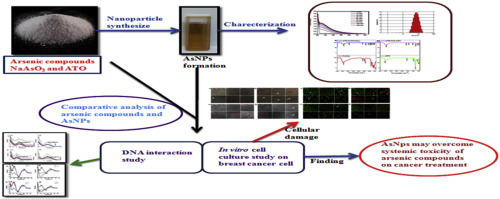Chemico-Biological Interactions ( IF 5.1 ) Pub Date : 2017-12-22 , DOI: 10.1016/j.cbi.2017.12.025 Ariraman Subastri , Viswanathan Arun , Preeti Sharma , Ezhuthupurakkal Preedia babu , Arumugam Suyavaran , Subramaniyam Nithyananthan , Ghedeir M. Alshammari , Balakrishnan Aristatile , Venkataraman Dharuman , Chinnasamy Thirunavukkarasu

|
Therapeutic applications of arsenic trioxide (ATO) are limited due to their severe adverse effects. However, nanoparticles of ATO might possess inimitable biologic effects based on their structure and size which differ from their parent molecules. Based on this conception, AsNPs were synthesized from ATO and comparatively analysed for their interaction mechanism with DNA using spectroscopic & electrochemical techniques. Finally, anti-proliferative activity was assessed against different breast cancer cells (MDA-MB-231 & MCF-7) and normal non-cancerous cells (HEK-293). The DNA interaction study revealed that AsNPs and ATO exhibit binding constant values in the order of 106 which indicates strong binding interaction. Binding of AsNPs did not disturb the structural integrity of DNA, on the other hand an opposing effect was observed with ATO through biophysical techniques. Further, in vitro study, confirms cytotoxicity of ATO and AsNPs against different cells, however at particular concentration ATO exhibits more cytotoxicity than that of AsNPs. Furthermore, cytotoxicity was confirmed through acridine orange and comet assay. In conclusion, AsNPs are safer than ATO with comparable efficacy and might be a suitable candidate for the development of novel therapeutic agent against breast cancer and other solid tumours.
中文翻译:

砷纳米粒子的合成,表征及其与DNA的相互作用以及对乳腺癌细胞的细胞毒性潜能
由于三氧化二砷(ATO)的严重不良作用,其治疗应用受到限制。但是,基于其结构和大小,ATO纳米颗粒可能具有独特的生物学作用,这与其母体分子不同。基于这一概念,从ATO合成了AsNPs,并使用光谱和电化学技术比较分析了它们与DNA的相互作用机理。最后,评估了针对不同乳腺癌细胞(MDA-MB-231和MCF-7)和正常非癌细胞(HEK-293)的抗增殖活性。DNA相互作用研究表明,AsNPs和ATO的结合常数值约为10 6这表明强烈的结合相互作用。AsNP的结合不会干扰DNA的结构完整性,另一方面,通过ATO通过生物物理技术观察到了相反的效果。此外,体外研究证实了ATO和AsNP对不同细胞的细胞毒性,但是在特定浓度下,ATO比AsNP具有更大的细胞毒性。此外,通过a啶橙和彗星试验证实了细胞毒性。总之,AsNP比ATO更安全,且具有相当的疗效,可能是开发针对乳腺癌和其他实体瘤的新型治疗剂的合适候选药物。

























 京公网安备 11010802027423号
京公网安备 11010802027423号